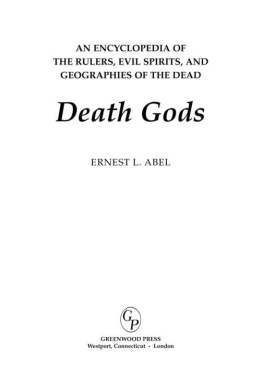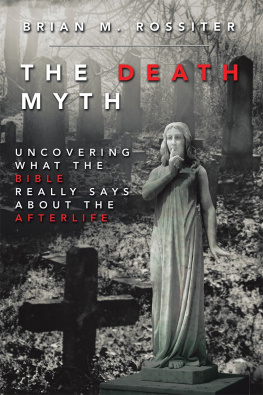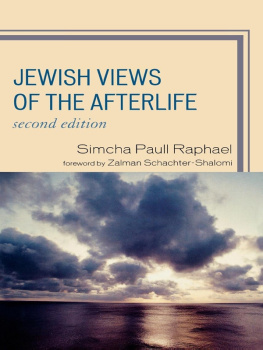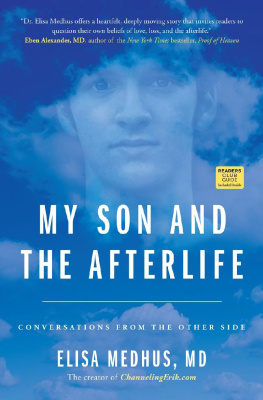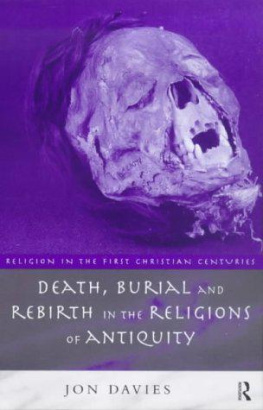Further Recommended Reading
Becoming Osiris: The Ancient Egyptian Death Experience. Ruth Schumann Antelme, and Stephanie Rossini.
The Quest for Paradise: Visions of Heaven and Eternity in the Worlds Myths and Religions. John Ashton and Tom Whyte.
The Hero with a Thousand Faces. Joseph Campbell.
The Myth of the Eternal Return, or Cosmos and History. Mircea Eliade.
The Politics of Myth. Robert Ellwood.
Ritual Texts for the Afterlife: Orpheus and the Bacchic Gold Tablets. Fritz Graf and Sarah Isles Johnston.
The Ultimate Journey: Consciousness and the Mystery of Death. Stanislav Grof.
The Wisdom of the Serpent: The Myths of Death, Rebirth and Resurrection. Joseph L. Henderson and Maud Oaks.
The Ancient Egyptian Books of the Afterlife. Erik Hornung.
Dionysos: Archetypal Image of Indestructible Life. Carl Krenyi.
The Ancient Mysteries: A Sourcebook. Marvin Meyer.
Alchemy: An Introduction to the Symbolism and Psychology. Marie-Louise von Franz.
Otherworld Journeys: Accounts of Near-Death Experiences in Medieval and Modern Times. Carol Zaleski.
Practicing Conscious Living and Dying: Stories of the Eternal Continuum of Consciousness. Annamaria Hemingway.
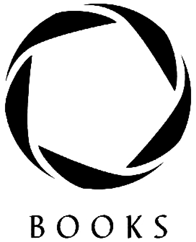
O is a symbol of the world, of oneness and unity. In different cultures it also means the eye, symbolizing knowledge and insight. We aim to publish books that are accessible, constructive and that challenge accepted opinion, both that of academia and the moral majority.
Our books are available in all good English language bookstores worldwide. If you dont see the book on the shelves ask the bookstore to order it for you, quoting the ISBN number and title. Alternatively you can order online (all major online retail sites carry our titles) or contact the distributor in the relevant country, listed on the copyright page.
See our website www.o-books.net for a full list of over 500 titles, growing by 100 a year.
And tune in to myspiritradio.com for our book review radio show, hosted by June-Elleni Laine, where you can listen to the authors discussing their books.
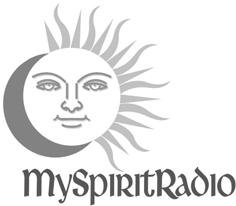
Bibliography and Selected References
Abram, David. The Spell of the Sensuous. New York: Vintage Books, 1977.
Alighieri, Dante. The Divine Comedy. Trans. Allen Mandelbaum. New York: Everymans Library, 1955.
Anderson, Hans Christian, and Rachael Isadora Turner. The Little Match Girl. New York: Putnam, 1990.
Bache, Christopher M. Dark Night Early Dawn: Steps to a Deep Ecology of Mind. New York: State of New York P, 2000.
Bede. A History of the English Church and People. Trans. Leo Sherley-Price. New York: Dorset Press, 1968.
Bierlein, J. F. Living Myths: How Myth Gives Meaning to Human Experience. New York: Ballantine, Wellspring, 1999.
Blake, William. The Marriage of Heaven and Hell. New York: Dover, 1994.
Bond, D. Stephenson. Living Myth: Personal Meaning as a Way of Life. Boston: Shambhala, 1993.
Campbell, Joseph. Myths to Live By. New York: Penguin Compass, 1993.
Corbin, Henry. Spiritual Body and Celestial Earth. Princeton, NJ: Princeton UP, 1977.
Doty, William G, Mythography: The Study of Myth and Rituals. Tuscaloosa: Alabama, UP, 2000.
Edinger, Edward F. Anatomy of the Psyche. Chicago: Open Court, 1991.
Eliade. Mircea. Myth and Reality. Trans. Trans. Willard R. Trask. Ed. Ruth Nanda Anshen. New York: Harper and Row, 1963.
Freemantle, Francesca. Introduction. The Tibetan Book of the Dead. By Guru Rinpoche According to Karma Lingpa. Trans. Francesca Freemantle and Chgyam Trungpa. Boston: Shambhala, 2000.
Grof, Stanislav. Books of the Dead: Manuals for Living and Dying. New York: Thames and Hudson, 1994.
Grof, Stanislav, and Joan Halifax. The Human Encounter with Death. New York: E. P. Dutton, 1977.
Grosso, Michael. The Archetype of Death and Enlightenment. The Near-Death Experience A Reader. Eds. Lee W. Bailey and Jenny Yates. New York: Routledge, 1996. 127-43.
Harrison, Robert Pogue. The Dominion of the Dead. Chicago: Chicago P. 2003.
Huxley, Aldous. The Doors of Perception & Heaven and Hell. New York: HarperPerennial, 1990.
Jung, C. G. The Archetypes and the Collective Unconscious. Trans. R. F. C. Hull. The Collected Works of C. G. Jung. Vol. 9:1. Bollingen Series 20, Princeton, NJ: Princeton UP, 1980.
-. Jung on Death and Immortality. Selected by Jenny Yates. Princeton, NJ: Princeton UP, 1999.
-. Memories, Dreams, Reflections. Ed. A. Jaffe. Trans. R. and C. Winston. New York: Vintage, 1989.
-. Psychological Types. Trans. Gerhard Adler, R. F. C. Hull. The Collected Works of C. G. Jung. Vol. 6. Bollingen Series 20, Princeton, NJ: Princeton UP, 1971.
Kearney, Michael. Mortally Wounded: Stories of Soul Pain, Death and Healing. New York: Simon & Schuster, 1996.
Kbler-Ross, Elisabeth. The Wheel of Life: A Memoir of Living and Dying. New York: Touchstone, 1998.
Moody, Raymond. Life After Life. New York: Bantam Books, 1988.
Osis, Karlis, and Erlendur Haraldsson. At the Hour of Death. New York: Hastings House, 1986.
Plato. Republic. Trans. G. M. A. Grube. Indianapolis, IN: Hackett P, 1992.
Ring, Kenneth. Life at Death. New York: Coward, McCann & Geoghegan, 1980.
van Gennep, Arnold. The Rites of Passage. Trans. Monika B. Vizedom and Gabrielle L. Caffee. Chicago: U of Chicago P, 1960.
Zaleski, Carol. Otherworld Journeys: Accounts of Near-Death Experiences in Medieval and Modern Times. New York: Oxford UP, 1987.
Chapter One
Myth: Fact or Fiction?
The term mythology refers to a body or collection of myths from any given tradition and derives from the Greek muthos, meaning tale or story, and logos, which is translated to mean speech. For many people, myths conjure up vague recollections of fanciful stories or epic tales and legends that are often associated with the fantasies of childhood fairy tales or the supernatural adventures of heroes, like Jason and the Argonauts or Odysseus, which originated in early Greek civilization. However, at a deeper level, many of these ancient stories preserve a history of how human beings have struggled to come to terms with death.
Although the most widely recognized mythologies tend to be those of the Greeks, Romans, and Egyptians, all world cultures have an important mythological heritage, such as that of the Mesopotamian, the Norse of ancient Scandinavia, the Celt of early western and central Europe, the Indian or Vedic, and that of the Christian-Judaeo tradition. While there is no specific universal myth, studies in mythology have uncovered how widespread are the many symbols and motifs that recur throughout various societies and eras. Many cultures include creation myths that tell of how the world came into being; these range from illustrating how supreme deities fashioned the Earth out of abstract chaos and myths that tell of recurring destruction and creation that are allegories to seasonal death and rebirth. The notion of a golden age from which the human being fell from grace is another common theme in the Christian-Judaeo tradition. The motif of the flood is also universal and plays a key role in myths that tell of the annihilation and recreation of the world, or a particular society. Nature myths also describe the origins of the elements and the gods who governed them. They demonstrate how ancient cultures discovered and revered a sacred power and magic in the natural world around them and how they believed that death related to the cycles of the sun, the moon, and the tides. The relationship between the living and the dead is a common characteristic in the mythologies of many world religions.


